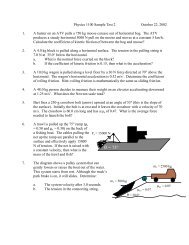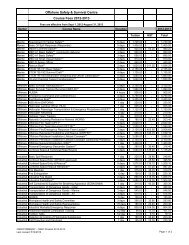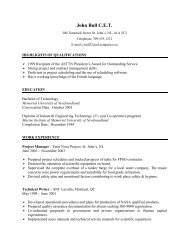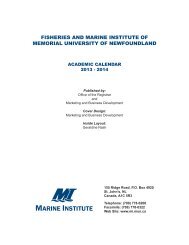Fishing Smarter: - Fisheries and Marine Institute
Fishing Smarter: - Fisheries and Marine Institute
Fishing Smarter: - Fisheries and Marine Institute
- No tags were found...
You also want an ePaper? Increase the reach of your titles
YUMPU automatically turns print PDFs into web optimized ePapers that Google loves.
NOT FOR REPRODUCTIONhose of you who have ever fly-fished for salmon,jigged a codfish, or hauled a lobster trap knowhow important it is to underst<strong>and</strong> the behaviour ofthe animal you are trying to catch. Whether it isrecreational or commercial fishing, those doing thecatching are constantly trying to outthink the animal theyare targeting. In fact, humans have learned to hunt allmanner of marine species over the years, whether theybe fish, shark, crab, snails, or squid. If it has worth, wehave probably figured out how to exploit the resource.Indeed fishing has been perfected over thous<strong>and</strong>s ofyears <strong>and</strong> is perhaps among the oldest professions onthe planet. Assuming even the earliest fishermen had adesire to be efficient <strong>and</strong> selective in what they caught,we can safely surmise they spent a great deal of timeperfecting their techniques, equipment, <strong>and</strong> knowledge ofanimal behaviour.<strong>Fishing</strong> <strong>Smarter</strong>:Improving HarvestingTechnology Throughthe Study ofAnimal Behaviourby Paul WingerMARINE INSTITUTEToday not much has changed in many regards.Commercial fishing enterprises still spend considerabletime making practical (<strong>and</strong> tactical) decisions about thetype of fishing gear to use <strong>and</strong> its operation. And yet formany fisheries, low catch rates of the target speciestogether with high bycatch of non-targeted animals isroutine. Unfortunately, steaming to new fishing groundsis often not enough to improve efficiency or avoidunwanted species. Often the only way forward is tomodify one’s fishing gear to be more selective by species<strong>and</strong> size. A critical step in this process is underst<strong>and</strong>inghow animals interact with fishing gear. You might besurprised to know that the likelihood of capture has justas much if not more to do with an animal’s behaviourthan with the fishing gear used to catch it. And it ishighly variable. Each species varies in its behaviour, <strong>and</strong>even this changes daily, seasonally, <strong>and</strong> with the growthof the animal. Not to mention daily <strong>and</strong> seasonaldifferences in environmental conditions, such as watertemperature <strong>and</strong> ambient lightintensity near the seafloor,together with anindividual’shunger level <strong>and</strong>experience can allCopyright Journal of Ocean Technology 2008All the Fishes that Swim, Vol. 3, No. 2, 2008 15
NOT FOR REPRODUCTIONhave a big influence on the response threshold <strong>and</strong>behaviour toward fishing gear.The study of animal behaviour in relation to fishing gearbegan as a formal scientific discipline among developedcountries in about the 1960s. Since that time, anincreasing number of government laboratories <strong>and</strong>universities have developed research capacity in thisarea. It is usually centred around either 1) thefundamental need to underst<strong>and</strong> <strong>and</strong> improve stockassessment, or 2) applied R&D for the fishing industry toimprove harvesting efficiency <strong>and</strong> selectivity. Together,this scientific body includes members from dozens ofcountries that meet annually to share new discoveries<strong>and</strong> developments.Types of Technology UsedPrior to the industrial revolution,observational techniques forstudying animal behaviour inrelation to fishing gear wereundoubtedly limited to watchingfrom the riverbank, peering over theside of a boat, <strong>and</strong> snorkelling.While simple <strong>and</strong> effective eventoday, they are severelyh<strong>and</strong>icapped in their ability toobserve at greater depths, reducedlight, increased turbidity, <strong>and</strong> cold temperatures. It wasnot until the post-war years that significant technologicaladvancements occurred in underwater breathingapparatus, optical camera systems, <strong>and</strong> acoustictechnology. In many cases, it has been technologydeveloped for military <strong>and</strong> medical use that fishing geartechnologists <strong>and</strong> fish behaviourists soon found a way toadapt for the study of fish capture behaviour.Direct observations by scuba divers was one of the firsttechnological strides in the 1960s. With the advent ofSCUBA, humans could now stealthily descend onto thefishing grounds <strong>and</strong> observe interactions betweenanimals <strong>and</strong> fishing gear. At first it was static gears suchas baited traps <strong>and</strong> impounding gears such as weirs <strong>and</strong>cod pots. But it was not long before divers developed theskill to dive on mobile fishing gears such as bottomtrawls, scallop drags, <strong>and</strong> clam dredges. The techniqueis still in use today <strong>and</strong> has been perfected to include theuse of multiple support vessels, two-way communicationamong divers, manned vehicles, etc. The approach isused by research teams at the <strong>Fisheries</strong> ResearchServices (FRS) <strong>Marine</strong> Laboratory in Scotl<strong>and</strong> as well asthe National Oceanic <strong>and</strong> Atmospheric Administration(NOAA) Southeast <strong>Fisheries</strong> Science Center Laboratory inPascagoula, Mississippi, USA. It is particularly usefulwhere investigations can be conducted in shallow wellilluminatedwaters.Underwater cameras are perhaps the most widely usedinstrument for observing animal behaviour in relation tofishing gear. They are small robust tools for the recordingof information in the field that can be later analyzed in thecomfort of the laboratory. Earlyversions were h<strong>and</strong> held butengineers soon developed watertight,self-contained recording unitsthat could be deployed onto fishinggear without the intrusion of adiver. Early versions were onlyGRAHAM SANGSTERFigure 1: SCUBA diver filming from the headline ofa bottom trawl.capable of still photography. Thetechnique has proven to beparticularly ideal under darkconditions as animals do notperceive the device until the flash is released <strong>and</strong> thephotograph taken. It is an unbiased means of recordinganimal behaviour without the worry that your recordingdevice may be altering the behaviour you are trying toobserve. But researchers soon yearned for motionpictures (video). Introduced in the 1960s, chargecoupleddevices known as CCD cameras <strong>and</strong> siliconintensifier tube (SIT) cameras became available. Not longafter, there were intensified CCD cameras (ICCD) <strong>and</strong>intensified SIT cameras (ISIT), helping propel scientificenquiry into deeper <strong>and</strong> darker waters where humanshad never before observed. Uptake of these devices infisheries research grew rapidly through the 1990s due totheir small size, relative robustness, <strong>and</strong> relatively lowcost. In the 21 st century, we are now seeing researchers16 THE JOURNAL OF OCEAN TECHNOLOGY • EssaysCopyright Journal of Ocean Technology 2008
NOT FOR REPRODUCTIONFISHERIES AND OCEANS CANADAFigure 2: Gear technologist preparing a camera system for deployment.employing multiple-camera systems throughout the fulllength of a bottom trawl, stereophotography for precisesize <strong>and</strong> swimming speed measurement, as well asinfrared lighting <strong>and</strong> laser scanning technology to pushthe limits of the depths <strong>and</strong> distances that opticalsystems can function.One of the common obstaclesof underwater video camerasis the storage of the images.In shallow applications, anumbilical to the surface isoften successful. It is realtime<strong>and</strong> cost-effective. Butfor deeper applications this isnot always practical or costeffective.One approachpioneered in Norway was thewireless acoustic transmissionFigure 3: Deployment of video system with umbilical to the surface.of live underwater video to the surface. But poor imagequality <strong>and</strong> low frame rate transmission has prevented itswide-scale uptake. Another more popular approach hasbeen to store the video in a recording bottle underwater<strong>and</strong> then retrieve it at a later time. Early versions werepurpose built customized devices. Today severalcompanies have now developed commercial off-the-shelfproducts. These recordingbottles have internal clocksthat are pre-set to turn on <strong>and</strong>off at determined times,contain batteries that sendpower out to the camera <strong>and</strong>lights (if desired), a captureboard that digitizes thereturning video, <strong>and</strong> arecording device to store theMARINE INSTITUTEimages. In fact, some of therecent designs can operateCopyright Journal of Ocean Technology 2008All the Fishes that Swim, Vol. 3, No. 2, 2008 17
NOT FOR REPRODUCTIONMARINE INSTITUTEFigure 4: Preparing a self-contained underwater recording bottle.several cameras simultaneously. But storage <strong>and</strong> powerare still major obstacles. Unlike an umbilical that providesunlimited power <strong>and</strong> recording ability, these systemseventually fill-up, burn-out, <strong>and</strong> must be brought to thesurface for download <strong>and</strong> recharging. Short-termdeployments on bottom trawls (< 2 hour tows) are acommon application. But 72 hour deployments on abaited crab trap or fish pot are still technically challenging.Technological advancements in solid-state memory <strong>and</strong>battery life have <strong>and</strong> will continue to provide significantimprovements, exp<strong>and</strong>ing the applications for these devices.Acoustic systems have also proven effective in the studyof animal capture behaviour, mainly because of theirincreased operational range <strong>and</strong> ability to penetrate dark<strong>and</strong> turbid waters where traditional optical (camera)systems fail to function. These systems includetraditional echosounders, sonars, <strong>and</strong> telemetry.Downward-looking echosounders <strong>and</strong> various sonarshave been used to investigate avoidance behaviour ofpelagic <strong>and</strong> demersal fish species to approaching vessels<strong>and</strong> trawls. They are most often mounted on vessels, butmore recently on towed bodies, remote operated vehicles(ROVs), <strong>and</strong> even autonomous underwater vehicles(AUVs). Advances in split-beam <strong>and</strong> multi-beamtechnology now provide multiple echoes of an individualfish while it is within the beam pattern, allowingestimation of its 3D displacement, orientation, <strong>and</strong>swimming speed. They can provide meaningful data onfish behaviour in complete darkness, strong turbidity, <strong>and</strong>at ranges (> 100m) optical systems could never match.Their main h<strong>and</strong>icap is that they cannot track individual18 THE JOURNAL OF OCEAN TECHNOLOGY • EssaysCopyright Journal of Ocean Technology 2008
NOT FOR REPRODUCTIONfish for more than a few seconds. So many observationsare typically aggregated to give researchers an indicationof what fish are doing at the school level.Telemetry is a complimentary acoustic technology thatoperates at the scale of the individual animal. Usingsmall animal-borne transmitters, researchers track themovements <strong>and</strong> behaviour of individual animals prior,during, <strong>and</strong> after an encounter with fishing gear. Attachingthe transmitters (called “tagging”) is usually the firstchallenge. Every effort must be made to ensure thecatching, h<strong>and</strong>ling, anesthetizing, <strong>and</strong> tagging doesn’taffect long-term behaviour once the animal is released.Different techniques have been developed, includingexternal attachment, implantation in the body cavity, <strong>and</strong>in the case of larger fish like cod, insertion into thestomach. In an effort to minimize stress on the animals,some have even developed in situ techniques in whichthe animals are tagged underwater, including voluntaryingestion of transmitters wrapped in bait (Atlantic cod offFigure 5: Attaching a camera <strong>and</strong> recording bottle to the headline of abottom trawl.Newfoundl<strong>and</strong>),underwatersurgery bySCUBA divers(rockfish offCalifornia), <strong>and</strong>subsea roboticsurgery pilotedfrom the surface(redfish offIcel<strong>and</strong>). Oncethe animals aretagged, anumber oftechniques canMARINE INSTITUTEFigure 6: Underwater observations of Atlanticcod inside baited fish pots.be used to “track” the animals <strong>and</strong> monitor their behaviour.Studies investigating capture behaviour in relation tofishing gear usually employ an array of fixed (listening)hydrophones in a relatively confined study area. Basedon differences in the time of arrival of the pings emittedfrom the transmitters at the hydrophones, accuratepositions of the animals can be computed every fewseconds. This technology has been used to study thereaction distance <strong>and</strong> search behaviour of crab towardbaited traps, cod toward baited longlines, as well as optimalreaction distance of plaice <strong>and</strong> cod toward approachingbottom trawls at different times of day <strong>and</strong> year.Looking ForwardAs we look to the future, it is reasonably apparent thatthe commercial fishing industry worldwide will continue toface increasing pressures, including new regulations,bycatch restrictions, species- <strong>and</strong> size-selectivity, <strong>and</strong>concerns over ecosystem impact. More than ever, theindustry is now faced with re-inventing fishing as asustainable <strong>and</strong> conservation-oriented means of exploitingthe oceans natural resources. This is a complex issuethat requires time <strong>and</strong> resources to resolve.MARINE INSTITUTEPart of the solution to this challenge is a betterunderst<strong>and</strong>ing of how animals interact with fishing gear.What kind of better underst<strong>and</strong>ing you ask? The answerI believe is two-fold:Copyright Journal of Ocean Technology 2008All the Fishes that Swim, Vol. 3, No. 2, 2008 19
NOT FOR REPRODUCTIONFISHERIES AND OCEANS CANADAFigure 7: Attachment of an acoustic transmitter to an adult American plaice.i) First, we must strive for improved integration <strong>and</strong>processing of observational data from multiple technologysources. Though much has been learned since theearliest studies in the 1960s, there are still many gaps inthe current underst<strong>and</strong>ing of how animals encounter, getcaught, <strong>and</strong> escape from fishing gear. Each technology,whether optical or acoustical, has its own inherentbenefits <strong>and</strong> limitations, <strong>and</strong> a combination of multipleinstruments is often necessary to underst<strong>and</strong> the captureprocess from start to finish. Integrating these data withan emphasis on the quantification of animal behaviour,not just descriptions of behaviour, is required.ii) Armed with this information, we must seek tounderst<strong>and</strong> why animals do what they do. Futureresearch must attempt to tackle the functionalexplanations behind behavioural expression. We need toexplore the costs <strong>and</strong> benefits associated with thedecisions that animals make <strong>and</strong> how to predict theprobable (optimal) decision under different conditions.For example, what are the behavioural trade-offs that fishmake in response to an attractive odour plume whensimultaneously engaged in spawning, or by contrast,what is the optimal avoidance distance to an approachingtrawler when actively engaged in feeding?In summary, several technologies now exist for theobservation of animal behaviour in relation to fishing gear.Depending on the application, researchers may use oneor more optical or acoustic technologies in order tounderst<strong>and</strong> the behavioural ecology of animals, theircapture process, <strong>and</strong> how it varies with species, size, <strong>and</strong>environmental conditions. This leads to informed decisionsabout fishing gear design <strong>and</strong> engineering, improving thespecies- <strong>and</strong> size-selectivity of the gear, reducingunwanted bycatch, <strong>and</strong> unnecessary discarding. Dr. Paul Winger is the Director of theCentre for Sustainable AquaticResources, an applied research unitwithin the <strong>Fisheries</strong> <strong>and</strong> <strong>Marine</strong><strong>Institute</strong> of Memorial University. Heholds a B.Sc. in <strong>Marine</strong> Biology <strong>and</strong>Oceanography from DalhousieUniversity, as well as an M.Sc. <strong>and</strong> Ph.D. from MemorialUniversity in the field of fish capture behaviour. You canreach him at Paul.Winger@mi.mun.ca, 1-709-778-0521,www.mi.mun.ca/csar.20 THE JOURNAL OF OCEAN TECHNOLOGY • EssaysCopyright Journal of Ocean Technology 2008
NOT FOR REPRODUCTIONCopyright Journal of Ocean Technology 2008All the Fishes that Swim, Vol. 3, No. 2, 2008 21
ISTOCKPHOTOIf you’re going to Travel...You’re going to READ.If you’re going to READ...Make it Count.Intelligent Reading... for your journey22 THE JOURNAL OF OCEAN TECHNOLOGY • Essays
















